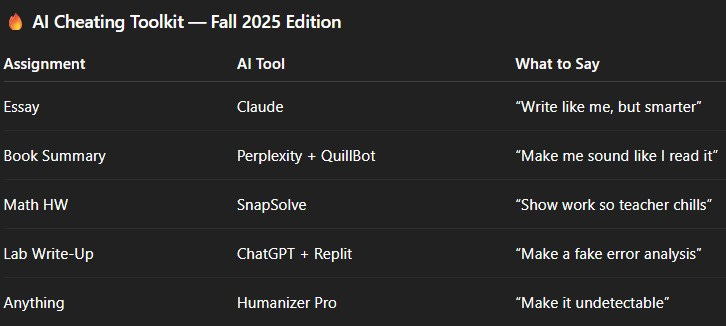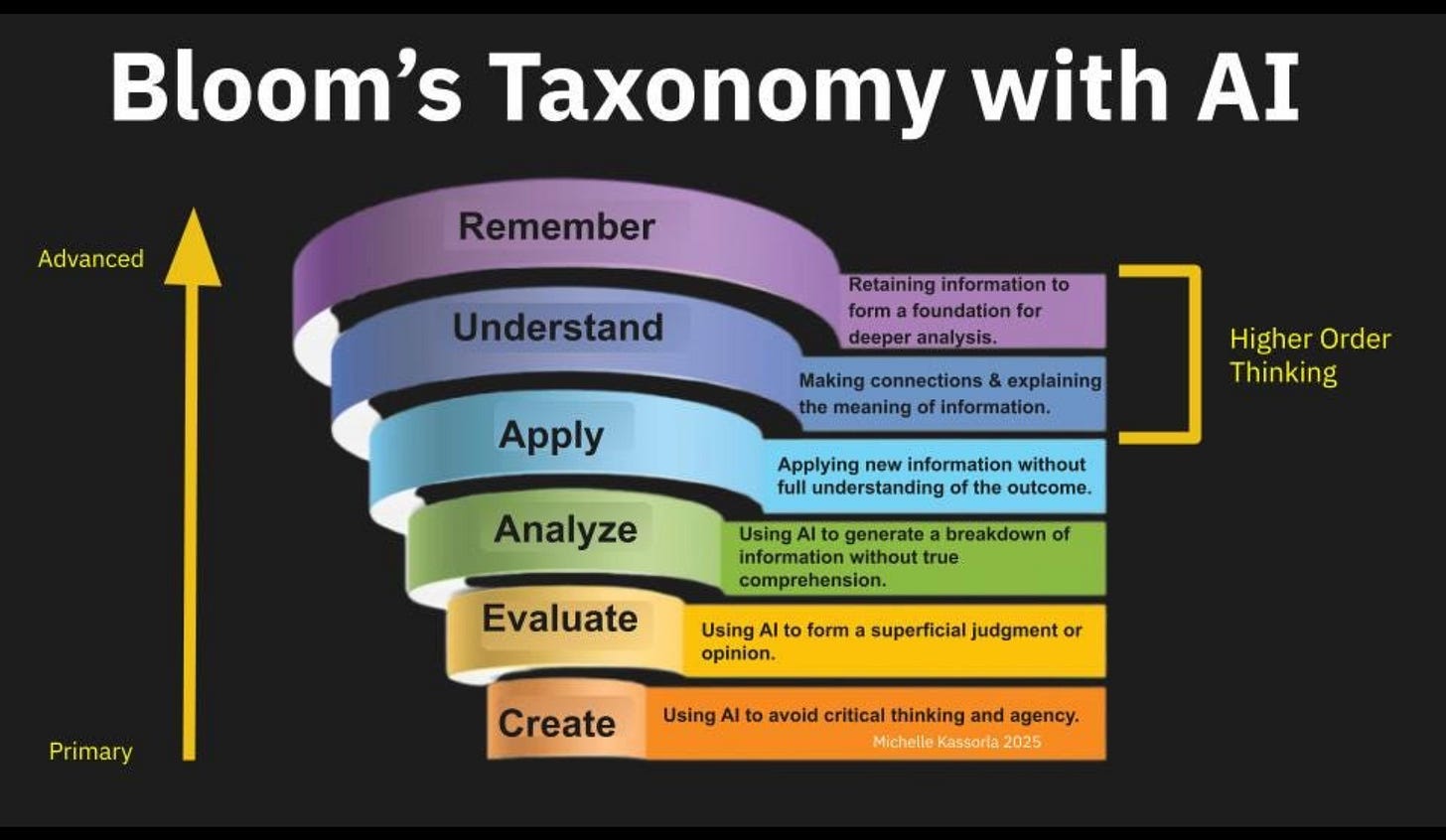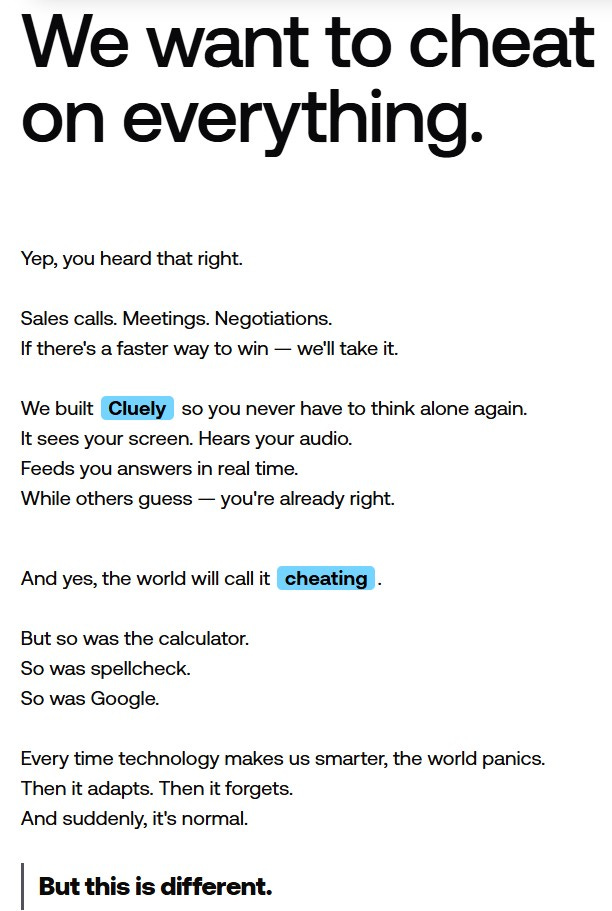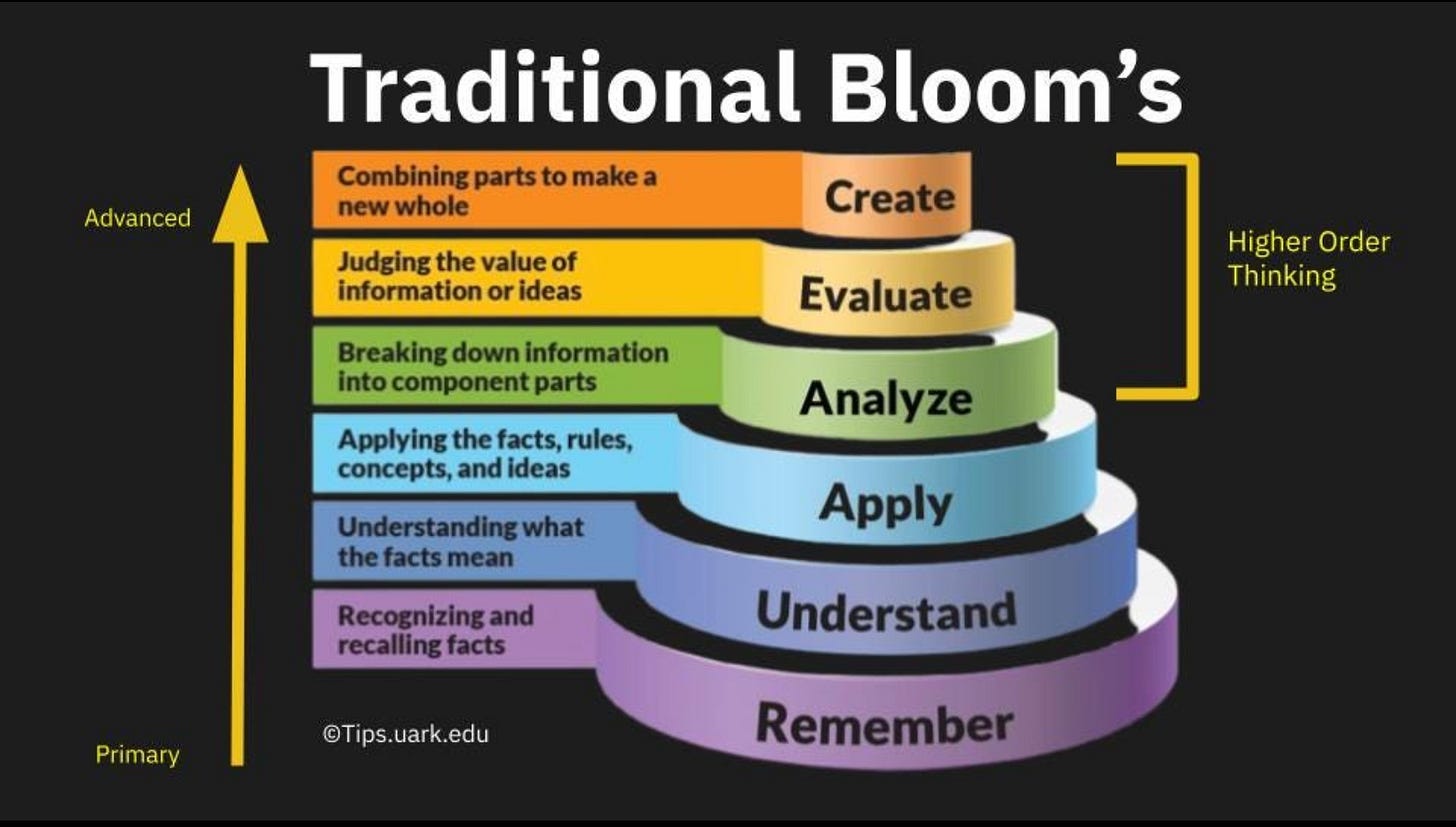I'm Going to Teach my Kids How to Cheat With AI
The lesson plan from hell, and a bit of a manifesto.
If it helps, if you’re getting palpitations, clutching pearls, or going into vapor lock, you can think of this as a “What If…?” thing.
They’ve been cheating with AI for over a year now. This fall, I’m showing them how to do it right.
I’ll walk them through it — ChatGPT, with Google Lens, with AI paraphrasers, with the Co-Pilot that’s baked into Microsoft Edge1.

There will be a PDF on my Canvas page with this breakdown:
Claude handles long reads. ChatGPT, Gemini, and Copilot are solid. Perplexity finds sources. QuillBot rewrites them. Smodin writes essays. SnapSolve, Photomath, and ChatBotAI solve math and show work. NotebookLM summarizes and podcasts your reading. Replit + GPTs = instant code. SciSpace explains research papers. Google Translate and DeepL take care of languages. If you want to come off like a douchey edgelord, try Grok.
Want to go full dark side? Undetectable AI, WriteHuman, and Humanizer Pro will scrub the AI fingerprints. Grammarly and Hemingway will clean it up for style points.
Train a custom GPT on class notes, rubrics, past tests. Notion AI, Otter, and Motion record everything, turn it into searchable transcripts, and hand it to your AI assistant. That’s not a shortcut. That’s infrastructure.
A major callout — Cluely2 takes notes for you, and has a manifesto that starts:
Oh, and the scenarios that really shiver the timbers of the testing-industrial complex representatives3:
You can train a GPT on years of released AP, IB, ACT, or SAT data and have it predict what’s next. Do it right, and you’ve got a 90% chance of building a test better than the College Board.
And wear your Meta AI glasses in the fall, so we assume they’re prescription. Skyler’s the obvious choice. By testing season, Cluely or something like it will scan what you're looking at and deliver answers in real time. No one’s checking your frames.

Turnitin? Not magic. AI detectors? Trash. Teachers saying “I can tell”? That’s what Humanizer Pro is for. Come on…don’t be stupid here, people4.
Students have been using these for over a year now. The system is broken. They already know how to beat it. Why play dumb denial games for one second longer than we have been?
Why, Dammit…Why?
Because perhaps I didn’t make it clear last time. All the stuff we’re doing? The baby steps, good feelings, meetings, group discussions, Gallery Walks, and putting post-its on the Parking Lot5 so we can talk about them at the next meeting? All of that shit?
Because PD won’t fix this.
Because someone rolled a d20 in my creation and came up with chaotic good6 for my character.
And, mostly, because our students are already there.
We’ve been acting like the adults at the end of Lord of the Flies, showing up to civilize kids who are already running the island. But they’re not savages—they’re just using AI better than we are. Pretending otherwise? That’s not discipline. That’s sabotage.
Kids aren’t cheating. They’re adapting. They’ve built their own ethics and uses for AI while we’re still pretending it’s optional. Calling that survival “dishonesty” isn’t discipline. It’s denial.
We’re not preparing them for the world they live in if we pretend AI doesn’t exist in their backpacks and browsers.
Let’s just take “AI cheating” off the table.
What Does This Prove?
You know, the usual7. And also that this isn’t about catching them cheating—it’s about helping them outgrow the need.
This isn’t a “feel good,” mealy-mouthed plea for intrinsic learning. Still, it does shift the focus from a product-based experience to one about the processes, the thinking, the discussing, and the wrestling with ideas.
Doing this may, in the end, accomplish the same goal, but it comes through the window, not the door.
Teaching them how to use AI to cheat, and letting them know I know about them, will open a new line of discussion: this isn’t about catching them using AI to cheat. It’s about getting them to outgrow the need to cheat. I know the game that’s being played here — it’s no fun to play anymore, when the house is in on it8.
Transparency builds trust. Pretending this isn’t happening? That wrecks it.
You don’t stop cheating by policing AI. You stop it by making learning matter.
Okay — let’s get to this, becuase I can hear it coming from some of my colleagues:
What About My Colleagues?
Yeah? What about them?
Some of the students I’ll teach will be their students too. That’s cool. I’m going to let my fellow teachers know my plans at the start of the year. I expect pushback.
It might be a tough year.
Many, many lunches in my room, all by myself. Ramen boiling over the Bunsen burner. Apple slices in a Ziploc on my desk. Sigh.
Some of y’all right now are thinking, “Why would you want to fuck with your colleagues like that?” My answer goes along the lines of, “If their practice is so behind the times that a kid with AI can completely game it, maybe they need to be fucked with.”

Maybe if it’s AI-doable, it wasn’t worth assigning. Maybe the book report should’ve died with the dial-up modem. Maybe we stop being mad at kids for using AI to write their reports while we use it to make our slides. That’s not irony. That’s hypocrisy.
Top 5 Signs Your Assignment Was Written in 2015
It includes the words “interactive notebook” and “PowerPoint.”
The rubric gives more weight to “clip art” and “border use” than “analysis.”
It ends with “create a Prezi or diorama.”
It bans Wikipedia, but pretends Khan Academy is cheating.
You truly believe the MLA header proves the essay was student-written.
Maybe this is a way to get us all, kicking and screaming in some instances, to update our stuff and make it for the world that exists today, not 10 years ago9.
This changes everything. Even sacred cows:

In a world with AI, understanding is the new top tier. That’s what sets students apart from GPT jockeys. That’s what we teach for now.
If you give an assignment that an AI agent can do in less than a second, can you justify to yourself and your students why they need to do it? I’m not saying there aren’t skills my students need to know — there will be plenty of equations balanced, stoichiometry problems and subatomic particles figured out by hand this year. But I can justify them. They need to understand the concepts.
So, Now That I’ve Ruined a Good Thing…
I mean, I get it. This is ripping off that Band-Aid. We could keep pretending. Coast on AI-assisted test scores. Raise school ratings on the backs of the bots. Smile and nod, right?10
I know what this is suggesting. Since AI can handle most assignments in five seconds, we can’t teach now as we’ve taught in the past. “Assignments” and “assessments” have new meanings, as does “cheating” and “plagiarism” (at least in the eyes of our students, and this is their world we’re living in). Upset? Annoyed? Get in line. Removing the option of using AI to cheat from the table won’t make students happy, either11.
So yeah — new ways, in just the start of broad strokes:
1. Make Thinking Visible (a.k.a. No Hiding Behind GPT):
If a bot can do it better, it wasn’t thinking in the first place. Do the work in class. Pens. Paper. People. Due by the bell. Stuff that gets made, not just submitted. Nothing to “do at home.” Because home is where the AI lives12.
2. Teach AI as a Tool, Not the Enemy (or the Getaway Driver):
Your students aren’t using AI — they’re working with it. Show them how to make it a co-pilot, not a ghostwriter. If a student’s entire contribution is copy-pasting a prompt and turning in results, why the hell are they even in the room?
(Sorry, not sorry.)
3. Go Full Goblin Mode With Problem-Based Learning:
Forget cookie-cutter projects. Throw them curveballs. Combine climate change + small-town politics + job loss + Gen Z rage. Let them wrestle with contradictions. Make it messy. If they can AI their way through it, it wasn’t a problem — it was a worksheet.
4. Redesign the Assessments (Kill the Zombie Rubrics):
Handwritten work. Open-ended questions. Public-facing work.
More “explain this to a 5th grader13” and less “summarize this chapter.”
Move from submission to exhibition. If no human is ever going to read it but you, maybe it doesn’t need to exist.
5. Reassure Them: This Is a Glorious, Glitchy Work in Progress
We don’t need to have it all figured out. We need to stop pretending we do.
Use something like the “0 to Infinity” scale to show the progression, not perfection.
Let kids see the growth. Let you see the growth. Because the real flex isn’t pretending we’re AI-proof. It’s adapting to the new reality. Let them see us learning as well.

I’m not teaching them to cheat. I’m teaching them to understand the cheat codes—so they won’t need them anymore.
We can’t AI-proof our classrooms. But we can trust our students enough to build something better with them — and make them places where they want to show up.
Thanks for reading.
Some of my favorite AI Thinkers lately:
Stephen Fitzpatrick: Teaching in the Age of AI
Anna Mills: Anna Mills’ Substack
Nothing will be new to them, really, and they already use several — like Co-pilot in Edge, dammit. On my tests. DammitDammit. That was my bad.
That raised north of $15 million in initial fundraising. You think Wall Street gives a shit that kids are cheating in school? Aww…you’re pretty. These are all multimillion-dollar tools backed by huge companies. Those that aren’t just have to prove their worth in the marketplace, and will be gobbled up by the huge companies.
Even though they tell us there’s no way to cheat on these important, important exams. Just like the fine folks from Canvas said…
If you are in 9th or 10th grade and describe something as “crucial, multifaceted” or “paramount,” come the fuck on. The same goes for overbaked transitions, a fake academic voice, or writing like the guy who used to narrate movie trailers: “Since the dawn of time…” Jesus, buddy. Calm the hell down and try instead to sound like a teenager who still (non-ironically) uses “what the hellyante?” in actual conversation with other human beings and saw The Minecraft Movie on opening weekend.
I’ve never understood the purpose of “gallery walks” or the “parking lot” concept, and my brother in Christ, who came up with this shit, if I ever meet you, I hope you can fight.
It’s a Dungeons and Dragons reference. Rather than me spelling it out, let’s go with this from The Alignment System: “A chaotic good character acts as his conscience directs him with little regard for what others expect of him. He makes his own way, but he's kind and benevolent. He believes in goodness and right but has little use for laws and regulations. He hates it when people try to intimidate others and tell them what to do. He follows his own moral compass, which, although good, may not agree with that of society. Chaotic good is the best alignment you can be because it combines a good heart with a free spirit. Chaotic good can be a dangerous alignment when it disrupts the order of society and punishes those who do well for themselves.”
My character roll. And of course, I know, one man’s “chaotic good” is another man’s asshole. I mean — not literally. That’s gross.
At least that’s the message I think I was supposed to take away from that scene in Casino with the guy’s knuckles and the ball-peen hammer.
I claim no place of pvieledge. Some of my stuff is kept around because I’m super-impressed with myself for making it. Ten years ago.
No. Jesus, new here? No.
Even some of the good kids that consistently get terrific grades. I said what I said.
And this - hopefully with exposing the cheat codes, we can take the shame away from using AI that the past year+ has put down for them to pick up.
The Feynman Technique, baby!






"If you give an assignment that an AI agent can do in less than a second, can you justify to yourself and your students why they need to do it?"
Sure. Because *doing it* is where pretty much the whole value comes from.
You might as well ask, if you can drive a five-mile loop in a few minutes, can you justify to yourself spending an hour jogging?
I'll be interested to read more about how this plays out in your classroom this year. I think it's a much better strategy than "let's pretend this isn't happening."